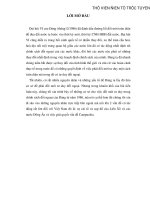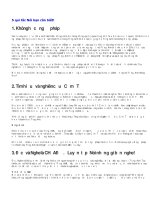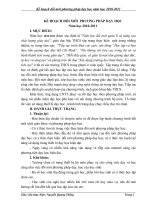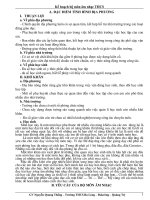cách đổi sang câu passive(hay)
Bạn đang xem bản rút gọn của tài liệu. Xem và tải ngay bản đầy đủ của tài liệu tại đây (38.98 KB, 7 trang )
I/Passive voice (P.V): is usually to emphasize the result, the fact or the object of an action ,not the
agent.
*P.V is used only with Transitive Verb
*P.V is used more commonly in written language , especially in the impersonal style of textbooks or
report ( to describe an industrial and scientific process, to describe historical and social process or in
official rules and procedures)
Ex :
The ore is usually dug out of the ground.
Applications should be made in writing.
II/Form
General form :
S+Vt+O ( Vt= transitive verb)
>PV:S(o) + be + P(2)+ (by O)
NOTE:
*to be in passive sentence is always in the same forms and tenses & main verbs in the active
sentence.
In P.V:
*To verb is changed into to be P(2)
*Verb is changed into be P(2)
*V-ing is changed into Being P(2)
*Modal verbs work in the same way :
S+ modal verb + Vt+ O
->P.V : S(o)+modal verb + be+P(2) + (by S)
Ex :
The windows in being painted .
The machine can be taken apart.
BASIC USES of passive voice
I/Agent and instrument:
*Agent : A person who does the action in the Passive sentence is called the agent
*Instrument : Things which cause something to happen in a passive sentence is called an
instrument .
Ex:
I was hit by a branch ( The branch itself hit me)
Iwas hit with a branch ( Some one use a branch to hit me ).
II/Transitive and intrasitive verbs :
1/Transitive verbs are the verbs with object.
There are 3 kinds of Vt( verb transitive )
[b]Memo-trasitive verbB] : verb with 1 object (read, write, )
Di-transitive verb :verb with 2 objects(give, bring,pay,hand,show )
Complex transitive verb
Ex:
I read the newspapers yesterday.
I gave her a present.
All Vt.s can be made passive except :become, have, get, suit, fit, resemble.
2/Intrasitive verbs are verbs with no object :
Ex:
The baby is sleeping.
The bird flies.
3/Some verbs are both transitive and intransitive verbs . "run" for example :
Ex :
He ran a shop > A shop was run by him .
He is running > (no passive)
* In this case, we focus on transitive verbs
To be continued
Hic hic, TNK được (hay bị) nhắc nhở
Thôi TNK gợi ý cách làm và công thức vậy nhé?
16. How many games has the team played?
- giữ cụm từ Hơw many games lại làm chủ từ câu passive.
17. What time can the boys hand in their papers?
- giữ cụm từ What time lại.
18. They had sent enough money to these poor boys.
-có 2 Obj: nếu không bị bắt buộc thì hãy lấy obj nào nằm ngay sau đông từ làm chủ từ câu passive,
sẽ dễ làm hơn.
19. People believe that 13 is an unlucky number.
20. They rumored that man was still living.
21. They think that he has died a natural death.
22. People believed that the earth stood still.
- 19, 20, 21, 22: Có 2 cách làm loại câu này:
- It is/ was + P.P + that clause
- Sub(mệnh đề sau)+ is/ was + P.P(V chính) + to Ininitive( V của mệnh đề sau, nếu 2 mệnh đề
khác thì sẽ phải là to + Have+ PP)
23. We'll continue to use this computer.
- xem continue như modal verb, vì không thể đổi sang pasive.
24. They began to plant rubber trees in big plantations.
- dùng began như với continue.
25. I have heard her sing this song several times.
26. People saw him steal your car.
27. The detective saw the woman putting the jewelry in her bag.
- 25,26,27: nhớ thêm to vào động từ nằm sau động từ chỉ tri giác!
28. Open your books
29. Don't do that silly thing again.
30. Don't let the other see you.
- 29, 30, 31: câu mệnh lệnh Let + S + Be+ PP
31. You need to have your hair cut.
- trường hợp need có chủ từ là vật.
32. You must see it to believe it.
- đổi pasive cả 2 verbs.
33. He wants someone to take some photographs.
- dùng công thức causative.
34. He likes people to call him "Sir".
- bỏ people và chuyển "to call" sang pasive.
35. it's your duty to do this work.
- nên dùng mẫu câu passive khác.
36. It's dangerous for us to take the short cut.
- đổi passive cho động từ take, và bạn nghĩ xem chủ từ sẽ là chữ nào? phải dùng dạng Infinitive
passive nhé!
37. We enjoy writting letters.
- cũng phải dùng dạng Infinitive passive nhé!
38. Smoke fills the room.
- câu này thêm 1 giới từ trước smoke
39. He recommends me to do the job.
40. She urges him to visit her parents as soon as possible.
- với 10 động từ Advise, Beg, Order, Urge, Recommend, Agree, Decide, Demand, Be dertermined,
Be anxious, dùng mẫu:
Sub + V (của mệnh đề chính) + that + Sub (sau To infinitive)+ should be + P.P (của To infinitive)
I/ Get + P(2) and Be + P(2)
*The difference between " get + P (2) " and " be + P(2)"
Get+ P(2) : is used to emphasize the action
Be+P(2) : is used to emphasize the state
Ex :
She got married 2 years ago .
She has been married for 2 years.
The vase got broken when we moved it .
NOTE :
*Get+P(2) can't be used for used for a major planned action.
Ex :
Wembley Stadium was built in 1923.( not : Wembley Stadium got built in 1923)
*We can use " Get+ P (2) in some idiomatic expressions ( in the file attached in the end of this
post)
Ex : There wasn't enough time to get washed
*After " get + P (2 ) ,there can be an adjective ending with ed.
Ex :
I had got interested in the film when the phone rang .
Some other adjectives are : bored , confused , drunk, excited , tired ,
To be continued
II/ Have something done Get something done
*The two pattern means almost the same . They all mean " cause sth to be done" . However, there
are still some different points.
( you can see the similarities and differences in the file attached at the end of this post)
III/ Active form with passive meaning:
1 /Gerund :
*After some special verbs , we use gerunds to express the passive meaning .
Ex :
These windows need painting .
The cupboard wants tidying
* Such verb are : need , want ( need) , require , deserve
2/ To+ V-infinitive
*After the subject " there" , we can use either an active or passive infinitive.
Ex :
There are a lot of windows to paint / to be painted .
There was some homework to do / to be done.
*After an adjective phrase, the infinitive is usually active.
Ex :
This machine isn't safe to use .
This piano is too heavy to move .
* If we use a phrase with " by " and the agent, then the infinitive is passive.
Ex :
The piano is too heavy to be moved by one person .
(=The piano is too heavy for one person to move ).
3/ Main verbs
*There are a few verbs that we can use in the active form with a passive meaning
Ex :
The singer's latest record is selling like hot cakes.
This sentence doesn't read quite right.
Special Passive Sentences
I/ The passive with the Verbs of reporting
There are 2 special patterns with Verbs of reporting, all of which can be accompanied by the agent
1/
It + be + P(2) V of reporting + that + finite clause
Ex :
It was reported that the army was crossing the frontier ( by the BBC)
The Verbs that can be used in this structure are (*):
Admit Agree Allege announce assume believe claim
consider decide declare discover establish estimate expect
explain fear feel find hope intend know mention
notice object observe presume promise propose prove
recommend regret report request reveal say see
show state suggest suppose think understand
2/
S+be+P(2)+ to V(infinitive
)
Ex :
Stonehenge is thought to date from about 1900 B.C
The Verbs can be used here are (**)
Allege assume believe claim consider declare discover
expect feel find intend know mean observe
presume prove report reveal see show suppose think
understand
CÁCH ĐỔI CÂU HỎI SANG BỊ ĐỘNG
Bước 1:
Đỗi câu hỏi sang câu thường
Bước 2:
Đỗi sang bị động như bình thường
Bước 3 :
Đỗi trở lại câu hỏi
ex:
Did he take it ?
1) đỗi sang câu thường
> He took it
2) đỗi sang bị động
-> It was taken by him
3) trở lại câu hỏi
-> Was it taken by him ?
+ Đối với câu hòi WH cũng vậy
ex:
What did he eat at school ?
1) > He ate what at school (what là túc từ nên cho vào vị trí của túc từ sau eat )
2) >What was eaten at school by him.
3) > What was eaten at school by him?(câu này trùng với câu lúc chưa là câu hỏi )
ex:
Who made you sad yesterday ?
1) >không thay đổi vì : S là what ,V là made,O là you
Who made you sad yesterday
2) You were made sad by whom yesterday
3) >By whom were You made sad yesterday?
Lưu ý là nếu ban đầu là câu hỏi yes/no thì đổi trả lại câu hỏi yes/no ,còn nếu là câu hỏi WH question
thì đổi trả lại câu hỏi WH question
Sau đây là một số mẫu câu bị động mà tại hạ tiếp thu được trên đường hành hiệp
people / they SAY that S V O
THINK
BELIEVE
mẫu này có 2 cách dổi sang passive :
cách 1:
-It (be) + P.P that (viết lại )
chọn động từ in đậm ở trên làm động từ chính ,to be tất nhiên chia theo thì của những động từ này
ex:
people said that he was a teacher
-> It was said that he was a teacher
-cách 2 :
Lấy chủ từ mệnh đề sau ra phía trước ,vẫn chọn động từ chính như cách 1 ,nhưng động từ của
mệnh đề sau đổi thành to inf
ex:
people said that he was a teacher
->He was said to be a teacher
Trong cách 2 cần lưu ý nếu hành động trong mệnh đề sau xãy ra trước hành động của mệnh đề
trước thì dùng công thức : to have been P.P thay cho to inf
ex :
they believed that he had taken the book
-> He was believed to have been taken the book
2)MẪU V O V
Là mẫu có dạng trong câu có 2 động từ đứng cách nhau bằng 1 object
a. nếu V1 là MAKE , SEE,HEAR ,NOTICE và các động từ giác quan khác và V2 là bare inf
thì khi đổi sang passive bare inf phải đổi thành to inf (riêng v1 là LET thì không đổi )
ex:
he made me go out
-> I was made to go out
He let me go out
->I was let go out
b.
Nếu V1 là các động từ chỉ sở thích như :like ,love ,hate,dislike
thì chọn V2 làm động từ chính ,cách đổi giống như công thức căn bản ,các yếu tố nào không liên
quan đến chủ từ thì viết lại ,be chia giống như động từ câu trên
ex:
he doesn't like people laughing at him
chọn laughing là động từ chính ,khi ấy túc từ của nó là him chủ từ (theo nghĩa ) là people
he doesn't like không liên quan đến 3 yếu tố SVO nên viết lại :
he doesn't like(him) being laughed at
(him) = he ở đầu câu nên bỏ. câu trở thành :
he doesn't like being laughed at
he wants someone to take some photographs
-> he wants some photographs to be taken
(luôn lưu ý be luôn chia giống động từ câu trên )
3)CÂU MỆNH LỆNH
-> let O be P.P
EX:
WRITE YOUR NAME ON THE BLACKBOARD
->Let your name be written on the blackboard
4) động từ là : COVER,CROWD, FILL
thì không dùng BY mà phải dùng WITH
EX:
Water covers the school yard
the school is covered by water (sai)
-> the school is covered with water (đúng )
5)có chữ DUTY
-dùng supposed
ex:
It's your duty to do this work
->You are supposed to do this work
6)có impossible
->dùng can't
ex:It is impossible to repair that machine
-> that machine can't be repaired
7) ENJOY +VING
EX: WE enjoy writing letters
-> We enjoy letters being written
7)có : RECOMMEND, AGREE,DECIDE,DEMAND,ADVISE,SUGGEST
-DÙNG MỆNH ĐỀ THAT + S + SHOULD
EX: he recommended selling the house
> He recommended that the house should be sold
Riêng các tự động từ : thường không đổi được sang bị động
ex:
He goes .
> không đổi được









